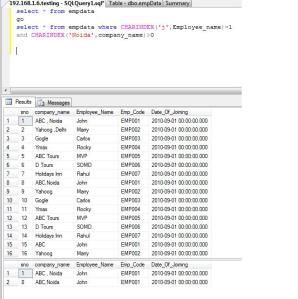Sometimes a situation comes wherein you want to do some action on any event fired by master page user control in to a content page.
We can do this by the help of "Delegates".
The situation is I have a user control with a dropdown in header.ascx file, which I have integrated in my masterpage.master.
Now I want to access the event of that dropdownbox (SelectedIndexChanged ) in my content page default2.aspx and the value of the drop down box.
How to do that ?
1. Create a Delegate and event Handler in your usercontrol.ascx.
//Creating delegate for dropdownlist
public delegate void OnSelectedIndex(object sender, EventArgs e);
public event OnSelectedIndex ddl_selectedIndexChanged;
2. Create a Delegate and Eventhandler in your Master page, which we will access in Content Page.
//Creating Delegates and Event handler
public delegate void MasterDropDown(object sender, EventArgs e);
public event MasterDropDown Header_DropDown;
3. Now access the same on content page
For this first call the master page like
<%@ MasterType VirtualPath="~/MasterPage.master"%>
//And then in your content page load method
protected void Page_Load(object sender, EventArgs e)
{
Master.Header_DropDown += new MasterPage.MasterDropDown(Master_Header_DropDown);
}
For Accessing the value
1. Define a property in ascx control
//Geting the Drop Down Value
public string DropDownValue
{
get { return DropDownList1.SelectedValue; }
}
2. Access the value in master page
//Geting the User Control value
public string UserControlValue
{
get { return uc_usercontrol1.DropDownValue; }
}
3. Now access the value in Content page in a lable
Label1.Text =Label1.Text+" "+ Master.UserControlValue;
Complete Code
User Control
uc_usercontrol.ascx
<%@ Control Language="C#" AutoEventWireup="true" CodeFile="uc_usercontrol.ascx.cs"
Inherits="uc_Usercontrols" %>
<asp:DropDownList ID="DropDownList1" runat="server" AutoPostBack="True"
onselectedindexchanged="DropDownList1_SelectedIndexChanged">
<asp:ListItem>1</asp:ListItem>
<asp:ListItem>2</asp:ListItem>
<asp:ListItem>3</asp:ListItem>
<asp:ListItem>4</asp:ListItem>
<asp:ListItem>5</asp:ListItem>
<asp:ListItem>6</asp:ListItem>
<asp:ListItem></asp:ListItem>
</asp:DropDownList>uc_usercontrol.ascx.cs
using System;
using System.Collections.Generic;
using System.Web;
using System.Web.UI;
using System.Web.UI.WebControls;
using System.Configuration;
using System.Collections.Specialized;
public partial class uc_Usercontrols : System.Web.UI.UserControl
{
//Geting the Drop Down Value
public string DropDownValue
{
get { return DropDownList1.SelectedValue; }
}
//Creating delegate for dropdownlist
public delegate void OnSelectedIndex(object sender, EventArgs e);
public event OnSelectedIndex ddl_selectedIndexChanged;
protected void Page_Load(object sender, EventArgs e)
{
}
protected void DropDownList1_SelectedIndexChanged(object sender, EventArgs e)
{
this.ddl_selectedIndexChanged(sender, e);
}
}
Master Page
MasterPage.master
<%@ Master Language="C#" AutoEventWireup="true" CodeFile="MasterPage.master.cs" Inherits="MasterPage" %><%@ Register Src="uc_usercontrol.ascx" TagName="uc_usercontrol" TagPrefix="uc1" %>
<!DOCTYPE html PUBLIC "-//W3C//DTD XHTML 1.0 Transitional//EN" "http://www.w3.org/TR/xhtml1/DTD/xhtml1-transitional.dtd">
<html xmlns="http://www.w3.org/1999/xhtml">
<head runat="server">
<title></title>
<asp:ContentPlaceHolder ID="head" runat="server">
</asp:ContentPlaceHolder>
</head>
<body>
<form id="form1" runat="server">
<div>
<uc1:uc_usercontrol ID="uc_usercontrol1" runat="server" />
<asp:ContentPlaceHolder ID="ContentPlaceHolder1" runat="server">
</asp:ContentPlaceHolder>
</div>
</form>
</body>
</html>
MasterPage.master.cs
using System;
using System.Collections.Generic;
using System.Web;
using System.Web.UI;
using System.Web.UI.WebControls;
public partial class MasterPage : System.Web.UI.MasterPage
{
//Geting the User Control value
public string UserControlValue
{
get { return uc_usercontrol1.DropDownValue; }
}
//Creating Delegates and Event handler
public delegate void MasterDropDown(object sender, EventArgs e);
public event MasterDropDown Header_DropDown;
protected void Page_Load(object sender, EventArgs e)
{
this.uc_usercontrol1.ddl_selectedIndexChanged += new uc_Usercontrols.OnSelectedIndex(uc_usercontrol1_ddl_selectedIndexChanged);
}
void uc_usercontrol1_ddl_selectedIndexChanged(object sender, EventArgs e)
{
this.Header_DropDown(sender, e);
}
}
Default2.aspx
<%@ Page Title="" Language="C#" MasterPageFile="~/MasterPage.master" AutoEventWireup="true" CodeFile="Default2.aspx.cs" Inherits="Default2" %>
<%@ MasterType VirtualPath="~/MasterPage.master"%>
<asp:Content ID="Content1" ContentPlaceHolderID="head" Runat="Server">
</asp:Content>
<asp:Content ID="Content2" ContentPlaceHolderID="ContentPlaceHolder1" Runat="Server">
<asp:Label ID="Label1" runat="server" Text="Hi I m visible now" Visible="false"></asp:Label>
</asp:Content>
Default2.aspx.cs
using System;
using System.Collections.Generic;
using System.Web;
using System.Web.UI;
using System.Web.UI.WebControls;
public partial class Default2 : System.Web.UI.Page
{
protected void Page_Load(object sender, EventArgs e)
{
Master.Header_DropDown += new MasterPage.MasterDropDown(Master_Header_DropDown);
}
void Master_Header_DropDown(object sender, EventArgs e)
{
//Here you can do any activity on change dropdown list
Label1.Visible = true;
//Accessing the Master page User Control Value in content Page
Label1.Text =Label1.Text+" "+ Master.UserControlValue;
}
}
Download Code


